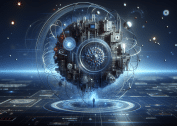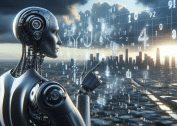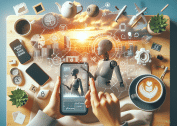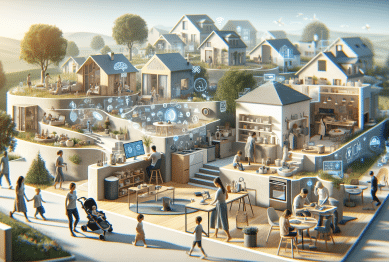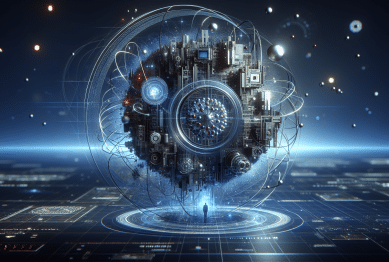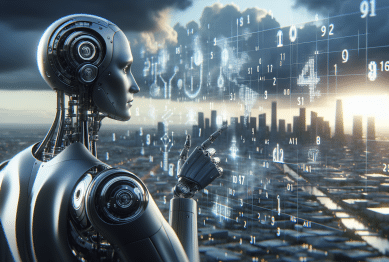Explore how artificial intelligence tools weave into daily routines, quietly streamlining tasks and offering surprising advantages in work, home, and leisure. This in-depth guide shines a light on practical AI applications transforming productivity and problem-solving for everyone.
The Unexpected Power of AI in Everyday Moments
Artificial intelligence, once reserved for laboratories and science fiction, now supports everyday routines in remarkable ways. Smart assistants, recommendation systems, and background services powered by machine learning quietly shape how information is processed and decisions are made. These omnipresent digital aids are propelling productivity by organizing schedules, responding to voice commands, and answering questions on demand. Even small tasks like sorting emails or setting reminders benefit from AI-driven algorithms that anticipate needs. Many discover AI features embedded within devices they already use—often invisible yet highly impactful. As more users harness AI for menial and creative tasks, the technology’s influence becomes clear: it isn’t distant or inaccessible but woven deeply into the fabric of modern life.
What surprises many is just how often AI quietly operates behind the scenes. From spell-checking tools to route planning and digital photo curation, artificial intelligence quietly steps in where it can minimize hassle and free up mental bandwidth. Recent advances in natural language processing allow seamless voice-driven commands, such as those used with smart speakers or chatbots for information retrieval. AI also offers support for accessibility, helping translate spoken words into text, providing automated captions, or enhancing hearing through adaptive volume technologies. While these tools feel intuitive to users, powerful neural networks work in the background to interpret and act on data. Ultimately, AI tools are not just for experts—they are everyday allies.
As the technology matures, society observes more AI being adopted across households and workplaces. Vacuum robots use sophisticated mapping, security cameras apply facial recognition, and streaming apps suggest shows using predictive analytics. For many, the main challenge is becoming aware of just how much artificial intelligence already underpins routine tasks. Whole ecosystems, including home automation, health management, and even home budgeting, are increasingly coordinated via AI-powered platforms. Exploring how these technologies shape choices and open new possibilities for convenience can be eye-opening for anyone interested in the future of technology at home and on the go.
How Machine Learning Enhances Daily Problem-Solving
Machine learning, a subset of artificial intelligence, refers to computer systems that learn from experience and improve their performance over time. Instead of being explicitly programmed with detailed instructions, these systems analyze data, detect patterns, and make informed decisions or predictions. This flexible approach has enabled AI to address everyday hurdles. For example, navigation apps draw on massive amounts of real-time traffic data to suggest the most efficient routes, adapting to accidents or road closures on the fly. Personal finance apps help individuals understand their spending and offer budgeting insights using machine learning techniques that forecast trends and flag anomalies. These subtle, continuous analyses result in smoother daily operations and less stress for users.
Education, too, benefits from AI-powered platforms that personalize learning paths for students. Adaptive software can assess comprehension levels and tailor exercises based on individual progress. Similarly, e-commerce platforms employ recommendation engines—powered by the same learning algorithms—to match customers with products based on browsing and purchasing history. This increases satisfaction and streamlines decision-making for both consumers and businesses. Machine learning’s self-improving nature ensures that these tools become better and more attuned to user needs over time. The feedback loop created by millions of global interactions further refines results and predictions each day.
Behind the scenes, industries leverage AI for maintenance, risk prediction, and logistics. By monitoring factory sensors or truck location data, algorithms predict when equipment may need repairs or routes can be optimized for fuel efficiency. These efficiencies often lead to lower energy bills, less downtime, and cost savings that ripple through the consumer economy. As organizations see significant advantages, many solutions once limited to major corporations are now accessible in consumer-grade products. Whether managing your schedule, shopping online, or simply driving to work, machine learning likely contributes to the outcome silently, making life more manageable and efficient for the everyday person.
Voice Assistants and Smart Devices: Quiet Helpers
Smart speakers and voice assistants have quickly become fixtures in many homes. Devices powered by platforms such as Alexa, Siri, and Google Assistant now allow hands-free management of lights, appliances, alarms, and even home security systems. Users simply speak requests—adjusting the thermostat, playing favorite songs, or getting answers to trivia—which the AI parses, processes, and acts upon within seconds. This streamlined user interface is made possible by advanced natural language processing and deep learning, which let devices interpret context and intent accurately. As a result, accessibility is drastically improved for those with physical or visual challenges, offering greater independence and comfort through everyday interactions.
The ecosystem of interconnected devices continues to expand. Refrigerators track grocery lists, washing machines optimize cycles based on load sensors, and even smart light bulbs learn occupants’ routines to adjust lighting accordingly. Over time, these devices start to anticipate user needs, such as preparing coffee as morning alarms ring or adjusting HVAC settings before anyone returns home. This leap from manual to anticipatory automation demonstrates the evolving intelligence built into everyday objects, relying on robust AI frameworks. Many users find their routines simplified and their focus shifted from mundane chores to more meaningful activities, thanks to these subtle yet profound technological changes.
Privacy and control remain critical. Many manufacturers offer granular settings for data sharing and permissions, responding to growing consumer awareness. Responsible use of AI in the home means balancing convenience with transparency and user empowerment. The development of privacy-centric AI models—designed to process data locally rather than sending it to the cloud—shows ongoing innovation in response to these needs. As technology continues to evolve, these tools promise to become even more adaptive and respectful of user preferences, proving you can enjoy enhanced automation without sacrificing control over personal data.
Visual AI: Smarter Cameras, Photos, and Media Experiences
Artificial intelligence has redefined photographic and media experiences for consumers and professionals alike. Smartphone cameras now employ AI to automatically adjust lighting, recognize scenes, and highlight faces, resulting in clear, vibrant photos with minimal effort. For video, AI-driven stabilization and noise reduction deliver professional-looking results even in challenging conditions. These algorithms learn from vast datasets, improving their ability to identify scenery, objects, and people. In security settings, AI-enabled cameras can differentiate between familiar faces and strangers or detect unusual activity, alerting homeowners promptly. When combined with cloud storage and edge processing, AI transforms simple devices into powerful, context-aware tools.
Photo management has also become less tedious thanks to visual search and organizational features. Users can look up images based on location, objects, or even emotional context—a capability driven by sophisticated deep learning. Creative professionals use AI-powered editing tools that suggest enhancements, offer automatic retouching, or even generate artwork from written descriptions. For content creators and marketers, these advances mean less time spent on manual tweaks and more focus on crafting compelling stories. On streaming platforms, AI curates recommendations and tailors viewing suggestions, ensuring each experience feels fresh and personally relevant. This seamless integration of technology elevates enjoyment and removes complexity from multimedia consumption and creation.
Concerns often arise around digital security and ethical use of facial recognition. Developers are responding by building robust consent tools, allowing users to manage data sharing proactively. Academic and policymaking groups are evaluating best practices for safe, equitable use of visual AI. Balancing innovation with individual rights is an evolving challenge. However, the pace of improvement in both user experience and security points to a future where visual AI continues to shape creativity, safety, and communication, all while empowering users to make informed choices about the role of technology in their lives.
AI in Health and Wellness: Emerging Avenues for Everyone
Artificial intelligence is opening new doors in personal health and wellness. Wearables equipped with AI track activity, heart rate, sleep cycles, and even detect anomalies, helping users make evidence-based lifestyle adjustments. Smart watches alert wearers to irregular rhythms, encouraging early visits to health professionals. AI also powers mobile apps that offer guided meditation, stress monitoring, and mental health support, delivering tailored advice or coping strategies. The integration of big data and predictive analytics allows these tools to move beyond simple tracking, towards proactive wellness suggestions.
Healthcare providers use AI for diagnosis and treatment recommendations, often improving accuracy and speeding up care. Many clinics deploy decision-support tools to flag medication interactions or identify patients at risk for certain conditions. Telemedicine chats, now common, use AI to triage symptoms and direct patients to appropriate resources efficiently. Beyond the doctor’s office, grocery and nutrition apps utilize AI to help users achieve balanced diets by recommending meal plans or analyzing ingredients for allergens. These applications support healthier living and personalized well-being for users of all backgrounds and skill levels.
Ethical and privacy considerations are leading topics as AI expands in health. Platforms increasingly emphasize transparent use of data, consent forms, and robust security safeguards to protect sensitive health information. Regulatory agencies and independent watchdogs continue to monitor the landscape, promoting standards that foster trust and fairness in AI-driven healthcare solutions. Responsible adoption offers the potential for better health outcomes, less administrative overhead, and reduced stress associated with daily health management, while continuously evolving to maintain public confidence and safety.
Future Outlook: How AI May Continue to Transform Daily Life
The next chapter in artificial intelligence promises even deeper integration within daily routines and society. Gartner predicts that nearly every consumer-facing application will include some form of embedded AI, making solutions smarter and more responsive to nuanced behaviors. Transportation networks are piloting fully autonomous vehicles and predictive maintenance systems. In workplaces, AI-driven knowledge management can automatically tag, file, and highlight relevant documents during meetings, minimizing friction in collaborative projects. As this technology becomes cheaper and more reliable, its reach expands to smaller businesses and local communities, multiplying positive effects.
In education, AI continues to suggest individualized learning experiences, identifying gaps and recommending targeted lessons for students. Creative fields may see AI automate repetitive editing or coding tasks, providing more freedom to focus on ideation and innovation. New applications also emerge in fraud detection, supply chain management, conservation, and public safety—all fundamentally grounded in the ability to analyze massive data quickly and accurately. While adoption rates and enthusiasm vary by region, the cumulative effect of many small AI improvements continues to shape a world where convenience, speed, and reliability are the norm rather than exception.
As AI continues to evolve, experts recommend building digital literacy and understanding the technology’s potential and boundaries. Many organizations and governments are rolling out public education programs and partnerships to demystify AI and encourage responsible participation. Being curious and open to new tools allows more people to benefit as artificial intelligence redefines what is possible in tech and science. Looking ahead, a future shaped by AI holds both promise and responsibility—one where everyone can participate in the transformation of daily experiences.
References
1. National Institute of Standards and Technology. (n.d.). Artificial Intelligence—What It Is and Why It Matters. Retrieved from https://www.nist.gov/artificial-intelligence
2. Pew Research Center. (2022). Public Perceptions of Artificial Intelligence. Retrieved from https://www.pewresearch.org/internet/2022/02/07/public-perceptions-of-artificial-intelligence/
3. U.S. Food & Drug Administration. (2021). Artificial Intelligence and Machine Learning in Software as a Medical Device. Retrieved from https://www.fda.gov/medical-devices/software-medical-device-samd/artificial-intelligence-and-machine-learning-software-medical-device
4. Brookings Institution. (2021). How artificial intelligence is transforming the world. Retrieved from https://www.brookings.edu/research/how-artificial-intelligence-is-transforming-the-world/
5. World Health Organization. (2021). Ethics and governance of artificial intelligence for health. Retrieved from https://www.who.int/publications/i/item/9789240029200
6. Gartner. (2021). Gartner Predicts Almost All New Software Products Will Contain AI. Retrieved from https://www.gartner.com/en/newsroom/press-releases/2021-10-19-gartner-predicts-almost-all-new-software-products-will-contain-artificial-intelligence



